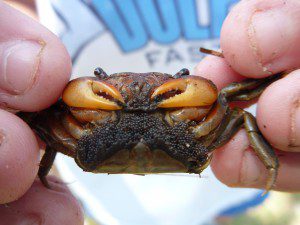
During their visit to FSUCML, Randall took the SciGirls to the small marsh next to the lab. One SciGirl found this fiddler crab carrying her eggs.
This video is part of the WFSU SciGirls project. SciGirls, for those who haven’t heard of it, addresses an unfortunate reality in the world of science- there are a lot more men doing research than women. It’s a problem that needs to be addressed as interest in science as a career has been waning overall. Every Summer, the SciGirls camp takes groups of teen and preteen girls into labs and into the field with scientists. After visiting Dr. Randall Hughes at the Florida State University Coastal & Marine Laboratory last Summer, a couple of SciGirls returned to conduct this interview.
Randall is a good role model for young aspiring female scientists. Aside from the fact that she herself is a female scientist, most of her lab- and that of her colleague Dr. David Kimbro- are females as well. If you’ve been following this blog, you’ve read about Emily Field’s graduate work on seagrass wrack and Kattie Lotterhos’ graduate work in genetics. In David’s lab, we’ve heard from Tanya Rogers, a lab technician who keeps David’s lab organized, and who is crucial in the planning and implementation of their large field experiments. We have more recently started hearing from Hanna Garland, Tanya’s fellow lab tech who is starting graduate school in the fall and who is looking into the abnormal levels of crown conchs on Randall and David’s Saint Augustine reefs. And we have also heard from Cristina Lima Martinez, an intern who comes to the Kimbro lab from Spain to study the Bay Mouth Bar ecosystem.
Interested in learning more about the SciGirls? Follow their blog!

2 comments
Hi Randall, what a wonderful program. This has inspired me to start a SCI/Girls club at my school. I have some other young citizen scientists that are helping me out with the annual FrogWatch count. I know I could get some others to follow along. You are amazing, not only in the work you do but being a mom to two great kids and making science happen for young women too!
Hi Carroll – Thank you for your comment! We were thrilled to interview Dr. Hughes for our video and we are so glad it inspired you to create a girls science club of your own! I encourage you to visit our SciGirls Tallahassee blog at http://scigirls.blogspot.com/ to find out more about our camp and maybe find some inspiration for your club as well.
Comments are closed.